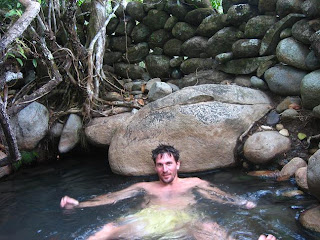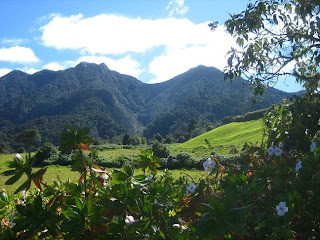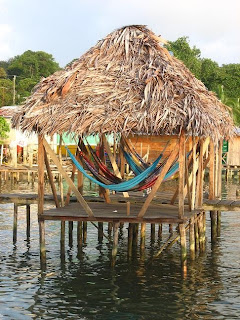View all photos from this sailing trip: http://share.shutterfly.com/action/welcome?sid=0AcNmzVq5YsWLE8AStrangely Panamá and Colombia are a rare example of neighboring countries not connected by road forming the only break in the Pan-American highway leading form Alaska to Chile (I say strangely because Panamá and Colombia used to be one country). Well, technically a road does exist (in fact a new one is about to be completed) but hardly anyone uses it because the area close to the border and into Colombia is very dangerous filled with drug smugglers, guerillas fighters, military checkpoints, paramilitary and other ordinary thieves and smugglers (in other words it remains a lawless land). So for all practical purposes a journey from Panamá to Colombia will require a boat or air plane or a combination thereof. After some research I decided that I wanted to travel exclusively by boat, specifically by sailboat, which has been a dream of mine for a long time. There are many sail boat owners that make a living transporting backpackers back and forth from Portobelo, Panamá to Cartagena, Colombia. They offer a 5-6 day journey leaving Portobelo arriving at the beautiful Caribbean island archipelago of San Blas the next day, then spend two days on the San Blas islands followed by a two day journey crossing to Cartagena (or so the theory goes).
But before you can go, you actually have to find a captain and boat. After a few days of searching and making many phone calls I finally tracked down the Swedish Captain Per and his 9 meter (30 feet) boat Tarona. He was ready to leave in a few days with 4 passengers. The remaining three adventurers were quickly found in my hostel so we set up a meeting with Per to discuss the details. After the meeting we decided Per was our captain (30 year of experience and some healthy craziness) and the Tarona our boat. The departure day was set for a few days in the future, weather permitting. Weather permitting being the key words because the night before departure Per calls us to postpone the trip by one day because the ocean waves were too high for him to even exit the harbor, let along cross the ocean. We eagerly call the next day to get an update only to be disappointed again. And so the waiting goes on and on while the weather gets worse and worse. But finally after a week of waiting (filled with fun nights in Panama City) the waves finally quiet down and the four of us (2 Israelis, 1 Canadian and myself) are on our way to the departure port of Portobelo. Portobelo is a sleepy fisher town surrounded by beautiful Caribbean beaches. In the Colonial days, however, Portobelo had a monopoly on shipping gold and other precious metals to Spain and represented one of the most important ports in the region. In a way Portobelo was the colonial central bank of Spain, surrounded by a protective fortress and home to tons of gold. Of course these shipments of wealth did not go unnoticed so the area became a popular target to pirate attacks and many legends still surround this place.
Per meets us with a friendly smile and we store our backpacks on the sailboat and after the introductory briefing and tour around the small boat we are finally on our way! We exit the harbor and turn around Drake’s island (named after the famous pirate Sir Drake who was buried there) and to our surprise what we find is too little wind but still a fairly rough sea. The journey begins at crawling speed and instead of arriving at San Blas the next morning, as planned, we arrive in the afternoon. But the trip would not be boring. As soon as we enter deeper waters we are surrounded by a school of dolphins that jump up and down and play around our boat. I have as much fun watching these amazing creatures as they have surfing through the waves. It turns out that this dolphin visit would turn into a daily occurrence. Almost every day we were visited by dolphins (sometimes up to 30 of them and staying with us as long as 8 hours).
Hearing about the prospect of fresh sea food, I quickly postpone my vegetarian principles and throw a fishing hook into the water. 5 minutes later I have a catch (beginner’s luck) - a delicious fresh tuna. To all of you who have never tasted fresh tuna, it tastes nothing like the tuna from the can and is absolutely amazing! The fishing continues and daily fresh fish become the tastiest part of our diet.
30 hours after our departure we finally reach San Blas, an archipelago consisting of 365 small islands (only about 40 of which are inhabited; most of them only by a few families as most islands are barely the size of a football field). For those of you that have never been to paradise, San Blas comes very close (or so I imagine): small islands covered with coconut palm trees swinging in the wind and white sand beaches surrounded by turquoise water (at 28 C degrees), sunny skies and a nice breeze keeping the temperature perfect and best of all: no mosquitoes. Here we spend two days snorkeling over colorful coral reefs filled with hundreds of even more colorful fish, relaxing in the shade of the palm trees, visiting and playing football with the very friendly local Cuna indigenous or going for a walk along the empty beaches. To this day the San Blas region maintains substantial autonomy from Panama and largely governs itself (e.g. no outsider is allowed to own land) in an effort to preserve the indigenous Cuna culture, ancient traditions and keeping their Cuna language alive. It really seems that San Blas remains one of the few forgotten jewels of this world almost untouched by tourism leaving the Cuna culture and its nature largely intact. Some memorable experiences of the Cuna people were: a spontaneous football game on the beach with a football handmade from plastic bags, a boy knocking on our boat one afternoon offering to exchange fresh fish for coffee and a visit to the main island to obtain our passport exit stamps for Panama. The immigration official in charge of stamping our passports is one of the most powerful men in the region because without his stamp one cannot leave or enter Panama. He knows the well and charges a hefty bribe to press the stamp down our passports. Our captain explains when refusing to pay the bribe one time, the official refused to do his job making up excuses and he was stuck in front of his office for weeks. The main Cuna Island was another terrific experience. While certainly being more touristy than the deserted islands, there still was very little western influence visible and the people seemed extremely happy and playful. Children running around the streets playing games, frequently coming up to us to greet us or involve us in their games. However the subject of taking pictures is a touchy matter and can cause angry words and an attempt to charge you money. But a solution quickly emerged; a little boy showed a lot of interest for my camera and after explaining the basic functions the excitedly ran around town taking pictures of all his friends (some of the photos turned out surprisingly well). To give you a sense of how relaxed of a place San Blas is, I spotted some hammocks in the local church! The way back from town to our boat was another unique experience: we were given a ride by a local fisherman and his 2 small children along with the fish he caught that day in a small wooden canoe across the big ocean weaves - but we arrived dry. It was difficult to leave San Blas and the captain’s offer to stay another day unfortunately was voted down 3 to 2 (the captain and myself voting in favor of staying). San Blas is an untouched paradise where I easily could have spent weeks if not months.
We depart San Blas and the last islands of Paradise behind us get smaller and smaller. In front of us 200 sea miles (2-3 days - an average speed of 4 knots per hours) of uninterrupted ocean. Soon the sun goes down and for some reason it is this darkness that that makes me realize how alone we are: no land in sight for 200 miles, no ships in sight either, 3000 meters of water underneath us, just the 5 of us and tiny Tarona dancing on the waves like a nutshell. Above us millions of starts show their beauty as the dolphins continue to dance around us. Our captain has divided each night on sea into 2 hour night shifts: 2 men watching while the others sleep (watching for other boats or approaching storm clouds and making sure the boat stays in course). The night comes and goes. The day comes and goes followed by another night, then day. The concept of time seems to blur as you sleep not with the cycle of the sun but when you feel tired. Given the roller-coaster motions of the boat there is very little to do (at day or night) but watch over the never-ending sea, let your thoughts wander or simply sit without thought or dialogue the wind in your face observing the vastness of the oceans.
So far I have been describing the romantic side the sailing, but make no mistake: there are some hardships and struggles. Let’s start with the seasickness. Within the fist day 2 of my companions started throwing up (one poor soul at least 8 times). Luckily I was spared but even I when going under deck or looking on a still object for a while had to hurry back on deck and put my face into he wind to avoid sickness. The first night we all slept on deck because no one could handle the rocking movements of being under deck (one of my friends never went under deck the entire journey, never ate more than 3 bites and was permanently white in the face). Everything on board takes twice as long as normally so preparing a simple meal can take 1-2 hours (but it is not like we did not have enough time), everything is difficult and cumbersome (from peeing to changing a shirt, taking a picture or walking to the other side to the boat), everything is small and crowded (I barely fit into the bed or bathroom and the kitchen was tiny) and wearing the same salty, sweaty, dirty clothes for 5 days. But with every additional day on sea, things got progressively easier, by the second night I was sleeping under deck and by day 3 I was able to read and write without getting dizzy. And so the hours passed as if it were a small eternity as if for 3 short days we had left civilization, had left the planet and had entered into our own plane of existence defined by different rules and by a different state of mind. At the same time life became very simple and still and all my worries, troubles and hurries moved very far away as if they had been taken by the wind.
Sailing is a very humbling experience in the sense that you are completely reliant on the forces of nature (wind and waves) to get to your destination. Lack of wind (or too much of it) or heading into the wrong direction can easily double or triple your journey). At the same time sailing is a great experience of independence: you with the help of the wind can go anywhere on the planet, can set your own destination. No one sets your schedule (you sleep when you are tired, eat when you are hungry and sail on when you are ready). Sailing also requires good preparation (you only eat and drink what you packed - there is not grocery story close by) if something breaks you have to fix it with what you have and improvise. Most of all sailing teaches you simplicity and patience, tow wonderful virtues in life.
Gradually after 6 days and 6 nights the Cartagena lighthouse comes into sight, our fist visual contact with Colombia. And although the lighthouse one represents a barely visible flicker on the horizon, it symbolizes the end of our voyage across the Caribbean and causes some cheers on board. However, it would still take us several hours until we could finally throw the anchor. Passing several large container ships we make it towards the port entrance and then maneuver along its long pass way toward the marina. Escorted by a Colombian coastguard boat we pass in between the green and red buoys, along he impressive Cartagena skyline, past the commercial port and its big cranes and container ships until finally with the cathedral glowing in the background we return the anchor into the water than I had lifted 6 days earlier. An unforgettable journey in so many respects comes to a close and I exit the Tarona with a distinct feeling that I will (one day) return to the world of sailing.









































